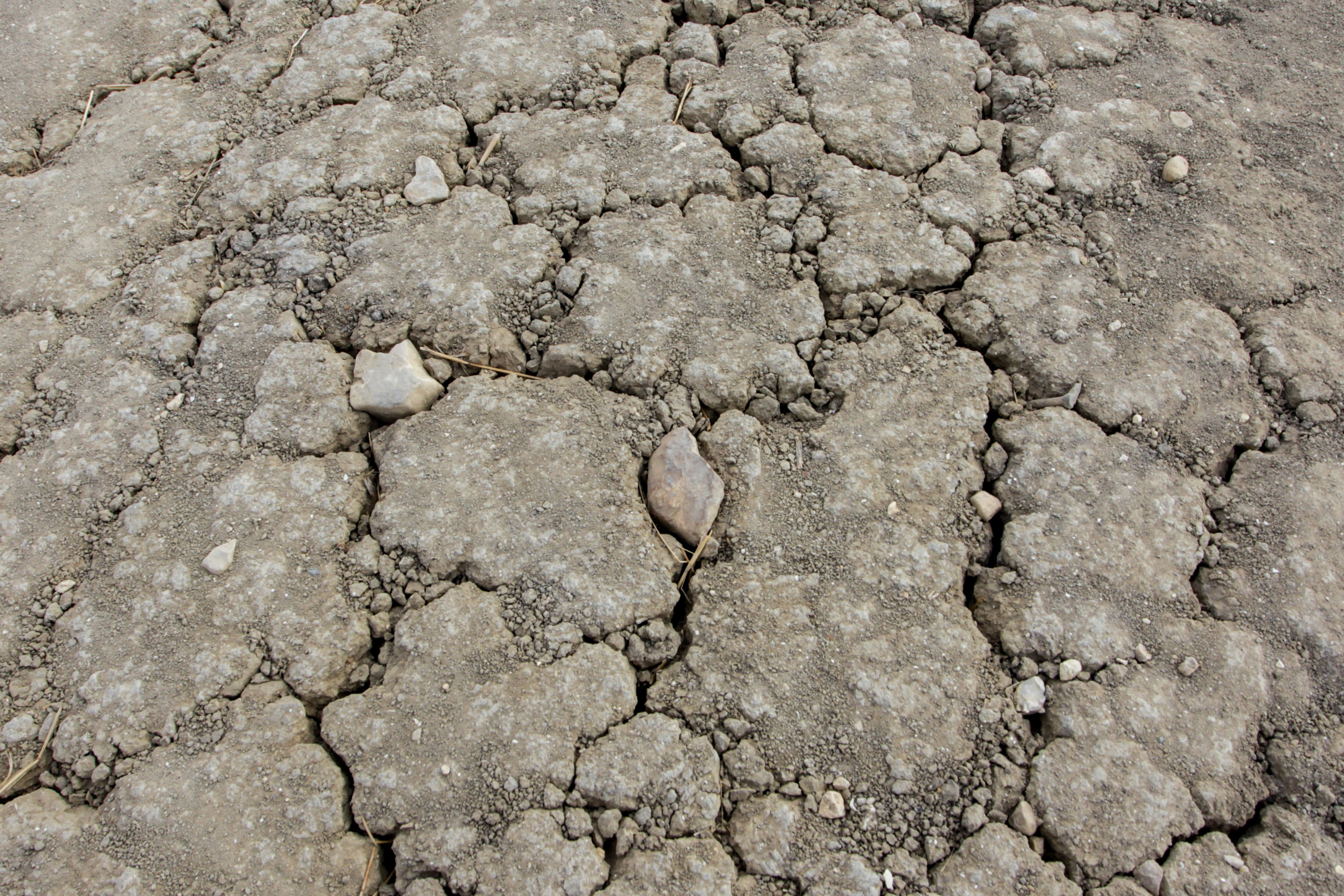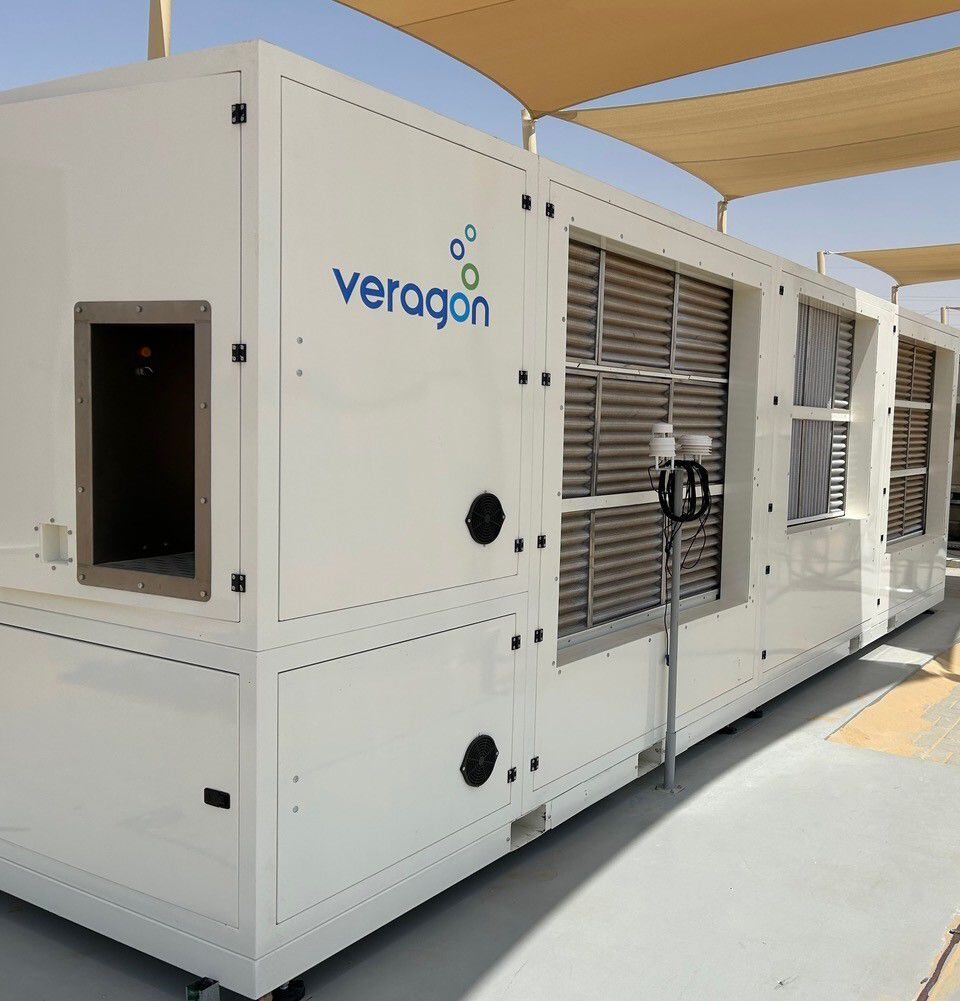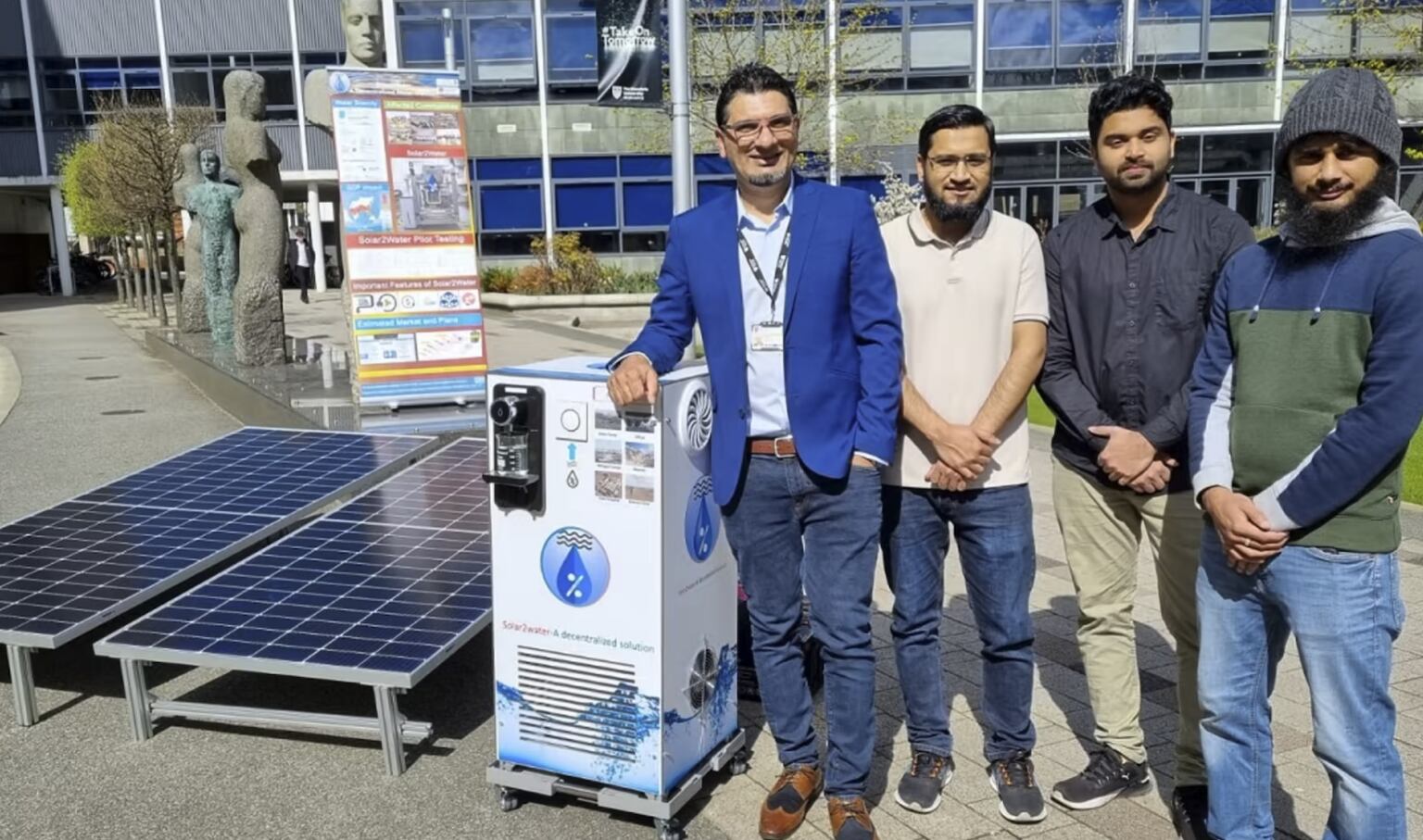More than 1.4 billion people around the world – including 450 million children – live in areas that face high or extremely high water vulnerability, the UN children’s agency said.
As a result, finding new and reliable sources of water is important for many communities, especially as the world’s population increases and climate change causes more severe drought.
While drilling boreholes and desalinating seawater are solutions, some researchers and companies believe another answer is all around us – in the air.
Nobody would think you could make drinking water from the air
Ian Ivory, founder of WatAir
As air-to-water technology and the ways to power it – including through solar energy – have become more efficient, a flurry of entrepreneurs have focused on it.
Three years ago, Ian Ivory launched WatAir, a company in Glasgow that converts air into drinking water.
He said previous generation air-to-water devices were comparable to the mobile phones of a few decades ago, which were renowned for their bulky size and short battery life.
But like mobile phones, air-to-water devices have evolved considerably since then.
“They will also be constantly improving, a bit like electric cars – each one that comes out will go further than the one before,” Mr Ivory said. “I think it’s got to the point where it’s fairly reliable and affordable.”

Water scarcity is a huge challenge for many parts of the world. Hasan Mrad for The National
Up in the air
Typically, commercial air-to-water devices take in ambient air, which ideally has high humidity, and cool it using an evaporator that contains refrigerants.
The moisture in the air condenses into water droplets, which can be collected and filtered. Minerals may be added to the water.
A condenser transfers the heat back to the air after the moisture has been removed and this warmer, drier air is released back into the atmosphere.
Commercially available devices vary widely in size, with smaller ones producing tens of litres a day at a temperature of 30°C and a humidity of 80 per cent. If the temperature or humidity is not ideal, a 30-litre device may instead generate about 18 litres in 24 hours.
The biggest devices are designed to generate as much as 10,000 litres every 24 hours.
Efficiency has improved, with Mr Ivory saying the power consumption of 10,000-litre devices has reduced by about a quarter in recent years.
Units can operate using solar panels and batteries, and there is said to be great interest in running devices off-grid, especially in developing nations.
Several units can be used together to generate industrial-scale quantities of water.

An air-to-water device by Veragon, an Italian company founded by Dr Alessio Lucattelli. Photo: Veragon
Mr Ivory said WatAir, whose units are manufactured in Malaysia, is involved in an off-grid project in Papua New Guinea in which 120 of the 10,000-litre units, supplied with solar power and batteries, will generate about one million litres of water a day.
While Mr Ivory describes the technology as having moved on significantly, he said “there aren’t that many people” producing air-to-water devices and knowledge of the technology remains limited.
“Very few people know they actually exist,” he said. “Nobody would think you could make drinking water from the air. Unless you were specifically looking for it, you wouldn’t come across the technology.”
Something in the air
Another company offering air-to-water devices is Veragon, an Italian company that was founded by medical doctor Alessio Lucattelli.
He describes air-to-water technology as being poised to become used much more often.
“It’s not a mass product yet, it’s a niche product that’s making its way through,” Dr Lucattelli said.
His colleague, Stephen White, who handles global business development for Veragon, said the technology was yet to reach its “tipping point”, in part because drilling boreholes to extract water is sometimes considered cheaper.
But he added that “underground water is not infinite”, alluding to the reality that many countries have reported dwindling groundwater reserves.

Air-to-water technology could be used to benefit rural communities in developing countries. Hasan Mrad for The National
So could air-to-water devices be the answer for communities that struggle to source adequate supplies? Erik Harvey, programme support unit director at WaterAid, said there was “a need for innovation in water supply systems”.
“The current water-from-air technologies in use are relatively complex and energy intensive, and result in a cost per litre that is not attainable for most of the poorer communities who currently don’t have a water supply,” he told The National.
“The technologies may well, however, have a viable use in humanitarian situations, and for the sale of bottled drinking water, where this might be able to compete in price with that of traditionally distributed bottled waters.”
WatAir is involved in numerous projects in developing countries and is hoping to supply units to health centres in South-East Asia.
Veragon has worked with the Asian Development Bank and describes air-to-water technology as being useful in areas where groundwater supplies are limited.
Mr White said high demands for electricity have previously limited the introduction of the technology, but the wider use of solar energy now makes this less of an issue.
“We have a Cambodian operation that went into operation in the early months of last year that is purely on solar,” he said. “The restriction is we only operate for maybe eight hours a day, but conversely there’s no environmental impact from the battery, and the cost is cheaper.”

Dr Muhammad Wakil Shahzad, from the University of Northumbria in the UK, with other researchers and the solar-powered Air2Water device. Photo: Dr Muhammad Wakil Shahzad
Education could hold the key
Companies and university researchers are continuing to develop new air-to-water technology, including at Khalifa University in the UAE, which last year announced it had created a system powered by solar energy.
At the University of Northumbria in the UK, Dr Muhammad Wakil Shahzad and his team have developed Air2Water, a patented device that uses an artificial intelligence-controlled combination of air-to-water technology, condensation and hygroscopy.
Hygroscopy involves water being absorbed into materials.
A disadvantage of hygroscopy on its own is that the absorbent material needs to be regenerated so that it can take in water again, which prevents the unit from running continuously. Dr Shahzad’s technology is said to eliminate this need through the smart integration of components.
By having solar panels and a battery, the device can produce water over a full 24 hours.
An additional advantage, he said, is that the unit can concentrate the humidity in the air, so that when the ambient air is dry the unit can still work to its maximum.
The technology is ideal for remote communities “in areas where there’s no grid supply available, there’s no water supply. Those are the ignored communities”, Dr Shahzad said.
The system can also be flown to disaster areas, he added.
Start-up EcotechX has been launched from Northumbria University with the aim of commercialising the technology.
“We are ready to commercialise the system that we have in the lab. We already have received two orders,” Dr Shahzad said, with one company in Mexico said to be interested in commercialising the system.
While air-to-water technology is not yet mainstream, it may play a part in providing water to the world’s growing population now numerous researchers and companies are selling their technology around the world.
News Related-
AWS and Clarity AI to use generative AI to boost sustainable investments
-
Ref Watch: 'Enough' of a foul to disallow Man City goal vs Liverpool
-
Day in the Life: Ex-England rugby star on organising this year's Emirates Dubai Sevens
-
Pandya returns to MI, Green goes to RCB
-
Snowstorm kills eight in Ukraine and Moldova, hundreds of towns lose power
-
‘This is why fewer Sikhs visiting gurdwaras abroad’: BJP after Indian envoy heckled in Long Island
-
Inside a Dubai home with upcycled furniture and zero waste
-
Captain Turner aims for Pitch 1 return as JESS bid to retain Dubai Sevens U19 crown
-
No Antoine Dupont but Dubai still set to launch new era for sevens
-
Why ESG investors are concerned about AI
-
Your campsite can harm the environment
-
Mubadala, Saudi Fund deals on US radar for potential China angle
-
Abu Dhabi T10 season seven to kick off with thrilling double-header
-
Eight climate fiction, or cli-fi, books to consider before Cop28
